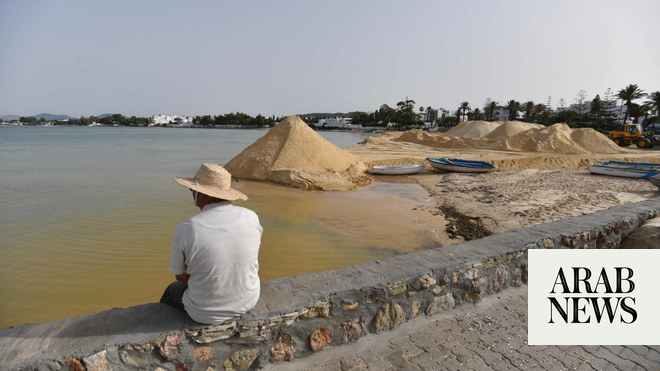HAMMAMET, Tunisia: In the Tunisian seaside town of Hammamet, bulldozers are busily shoveling sand from the nearby desert onto a popular beach in an effort to prevent it from disappearing due to erosion.
“This beach is a postcard image of Hammamet,” said environmentalist Chiheb Ben Fredj, peering nostalgically at the city's iconic Yasmine beach.
“It's been seared into our minds since our childhood,” he added, as workers worked to restore the central Tunisian waterfront to its former sandy glory.
Like many other coastal areas in North Africa, severe erosion has seen many of Hammamet's sandy beaches disappear in recent years, taking a toll on the holiday hotspot about 65 kilometers (40 miles) east of the capital, Tunis.
Coasts around the world are constantly changing naturally as the sea claims and deposits sediment.
But human activity, including coastal real estate development and offshore sand mining, is greatly accelerating beach erosion.
Among other impacts, construction and coastal defenses in one area can prevent sediment from moving along the coast, stripping existing beaches of new material.
Studies have also shown that the effects of climate change, including rising temperatures and sea levels, are exacerbating the phenomenon.
In the Mediterranean, where sea levels have risen faster in the past 20 years than in the entire 20th century, according to Britain's National Oceanographic Centre, coastlines are changing rapidly.
The sea is also warming 20 percent faster than the rest of the world, according to the United Nations.
The Tunisian coast is a major asset for the Mediterranean country with a struggling economy as it aims to welcome around 10 million tourists this year.
Tourism accounts for up to 14 percent of the country's GDP and provides tens of thousands of jobs in a country where unemployment is 16 percent and 40 percent among young people.
Tunisia has already lost more than 90 kilometers of beaches to erosion, according to official figures from last year.
Of the country's 570 kilometers of sandy beaches suitable for swimming, 190 kilometers are at risk of imminent disappearance, according to Tunisian reports.
Most of the beaches most affected by erosion are located near cities.
Tunisian environmental groups, as well as the government's Coastal Protection and Development Agency (APAL), blame the rapid erosion primarily on human activity and coastal construction, which they say is further exacerbated by climate change.
“The construction projects were not designed to respect the dynamics of the coast,” an APAL representative told AFP.
To save Hammamet beach, which the World Bank says is one of the most affected in Tunisia, authorities last month began transporting about 750 trucks filled with sand from the inland desert province of Kairouan, about 110 kilometers away.
APAL, which operates under the Ministry of Environment, was in a race against time to refill the beach before the peak tourist season.
But while beach restoration, known as beach nourishment, can be a quick fix, “it's not a sustainable solution,” said Ben Fredj.
“This sand may not last long,” added the general secretary of the Environmental Education Association.
“In the case of a storm, it could be swallowed up in a few days,” he said, just as it was in the summer of 2023.
The process can also prove to be expensive.
Coastal authorities have estimated the cost of sand restoration at three beaches in Hammamet, Monastir and Sfax at 3.9 million Tunisian dinars ($1.25 million).
But for local residents, restoring their priceless coastline is worth the money.
Yasmine Beach “is the showcase of Hammamet,” said Narjess Bouasker, who runs the city's Menara Hotel and heads the regional hotel federation.
“We have to take back our beach that has been swallowed up by the sea,” she said, calling for a balance between protecting the landscape, valued by local and foreign visitors, and fighting coastal erosion.
“For us, it's a priority not to touch the beauty of the city,” she said.
Bouasker said she has seen a growing awareness among authorities, but replenishing beaches with sand is still a gamble.
“We don't know how the sea will react,” she added.
